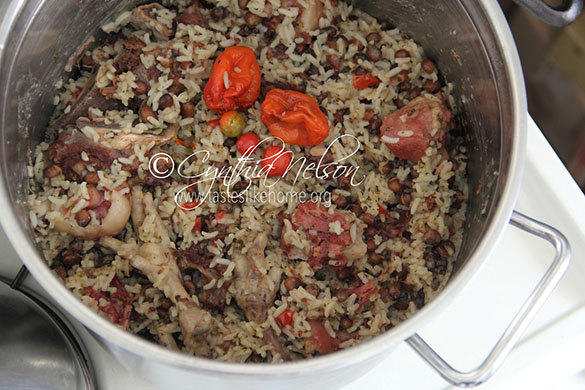
I believe that cooking is a very personal thing. Some people may be more skilled than others. Whenever I get the opportunity (which is infrequently) I enjoy watching people cook — I’m talking here about real home cooks not television cooking. You learn so much about how they engage and communicate with and through their food. Part of it is that you get to “see” that “secret” ingredient, usually called love. Of course, you pick up tips and learn new and different ways to do things too. It might be the tiniest little thing. I remember watching one of my cousins dip a spoon into a bottle of instant coffee and then tap the handle of the spoon twice against the rim of the bottle to get the right amount of coffee for the cup she was about to make. As she moved from one cup to the other, her actions were different because she was making individual cups of coffee for different people and each took their coffee differently — by strength, quantity, and sweeteners like sugar and milk. There is no right or wrong. I say all of this as a preamble to make the point I want to today because I was asked a question: How come the Cook-up come out so soft and clammy together?
Another cousin of mine made a pot of Cook-up Rice not too long ago and while he and everyone enjoyed the taste and flavour, he was frustrated at how the Cook-up turned out — the rice was very soft, somewhat pasty, the blackeye peas had all but melted and when cooled, everything became a large mass. To serve, the pot spoon cut through the Cook-up to be put on plates and then spread out. I was not surprised by the outcome, or, what I would call, the stirring conclusion, hence the voice in my head. You might be thinking, “But Cynthia, you could have certainly offered a bit of advice.” I couldn’t – not at the time he was cooking and because of his confidence in his own cooking. He is a very good cook! However, when he did ask, I explained why the Cook-up turned out the way it did.
Rice is a starch, and the longer it cooks and the more it is agitated – stirred, turned, it will break down and disintegrate, turning to mush. And this is rice being cooked on its own, now imagine adding another starchy component like blackeye peas along with creamy coconut milk, and stirring and stirring; you are bound to head in to pudding territory. Stirring speeds up evaporation when cooking, so the constant stirring by my cousin making the Cook-up meant that the liquid was drying out, the rice and peas were getting softer, melting; and then he kept adding more coconut milk concerned about the rapid drying out of the pot.
What should have happened is that once the adequate amount of cooking liquid was added and the pot given a good stir to mix everything together, and tasted, the heat needed to be lowered and the pot covered tightly to generate steam that would rise to the top creating an oven-like atmosphere cooking the food at the top of the pot. Covering the pot here was key because not only was the constant stirring speeding up the drying out of the liquid, but the pot uncovered, meant the steam would dissipate, and do so, quickly.
Cook-up Rice is not an easy dish to cook, it takes skill and practice. For one, there are many variables to consider – the type of ingredients that each require different cooking times; heat, and liquid. Everything must come together in a comfortable way that says we are friendly but not smothering.
When we cook, we should only stir our food when it is necessary. We stir to mix ingredients as we would with rice and peas for an even distribution. We stir when we season with salt and pepper so that everything has taste when cooking is done. We stir to create a homogenous mixture such as we would when mixing a cake. We stir to evenly disperse heat – the bottom of a pot or pan is always hotter than the top, so we stir to distribute the heat. We stir to alter viscosity of a liquid – to make it thin or thick. All of these are good and necessary reasons for stirring the pot. However, too many of us when cooking, stir the pot unnecessarily and too frequently and this can seriously impact the final product. I believe that our constant stirring comes from a place of insecurity, for a variety of reasons. And yes, some of it is from a lack of knowledge, practice and experience. It is easier said than done, but we really do need to trust ourselves more.
On the other hand, there are dishes that necessitate constant and frequent stirring, for example, Cornmeal Cou Cou. Another dish is the Indian white fudge called Peda/Peera when made from scratch not with condensed milk. The constant stirring of Cou Cou is to create a smooth creamy consistency developed from the slow release of starch to create a wholesome mass when done. In the case of the Peera/Peda, it is to avoid the milk “catching” (scorching the bottom of the pot/pan) and not developing a colour.
The next time you are making Cook-up, just remember, you are not making the northern Italian rice dish – Risotto which does require cooking with lots of liquid until starchy, wet and creamy soft.
Cynthia
cynthia@tasteslikehome.org





